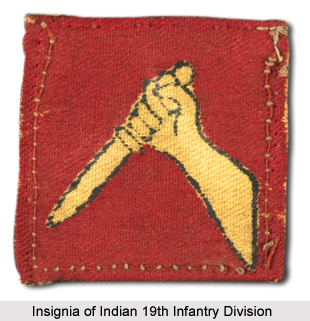 The Indian 19th Infantry Division was a former infantry division of the British Indian Army that served during the Second World War. It also played a major role in the last part of the Burma Campaign. Indian 19th Infantry Division was formed in 1941 in Secunderabad in the state of Andhra Pradesh. The division initially comprised of the 62ndIndian Infantry Brigade, the 63rd Indian Infantry Brigade and the 64th Indian Infantry Brigade. Major General Jackie Smyth VC was appointed as the first commanding officers. Later Major General Thomas Wynford Rees was appointed as the commander in late 1942. The divisional insignia was a hand forcing a dagger overhand, in yellow on a red background. Thus the British Indian division was also known as the Dagger Division.
The Indian 19th Infantry Division was a former infantry division of the British Indian Army that served during the Second World War. It also played a major role in the last part of the Burma Campaign. Indian 19th Infantry Division was formed in 1941 in Secunderabad in the state of Andhra Pradesh. The division initially comprised of the 62ndIndian Infantry Brigade, the 63rd Indian Infantry Brigade and the 64th Indian Infantry Brigade. Major General Jackie Smyth VC was appointed as the first commanding officers. Later Major General Thomas Wynford Rees was appointed as the commander in late 1942. The divisional insignia was a hand forcing a dagger overhand, in yellow on a red background. Thus the British Indian division was also known as the Dagger Division.
History of Indian 19th Infantry Division
The Indian 19th Infantry Division mainly performed internal security duties and served in training. Later in 1944, it was stationed in the Burma front. The troops of the division became a part of Indian XXXIII Corps and played a significant role in the capture of Mandalay. Later it was reassigned to the IV Corps. The Indian 19th Infantry Division included several British Indian infantry brigades during the Second World War. The brigades attached to the division were 99th Indian Infantry Brigade, 98th Indian Infantry Brigade, 64th Indian Infantry Brigade, 62nd Indian Infantry Brigade, 49th Indian Infantry Brigade, 48th Indian Infantry Brigade, 47th Indian Infantry Brigade, 9th Indian Infantry Brigade and the 22nd (East Africa) Infantry Brigade as well.
Development of Indian 19th Infantry Division
After the nation achieved independence and the formation of the Union of India in August 1947, the Indian 19th Infantry Division was included as a part of the modern Army of India. The troops served in the Indo- Pakistani War of 1965. The division comprised of several brigades, namely the 268th Indian Infantry Brigade, the 161st Brigade and the 104th Brigade. It served under the command of the Indian XV Corps.
Formation of Indian 19th Infantry Division
In 1945, the Indian 19th Infantry Division consisted of the following brigades-
62nd Indian Infantry Brigade
* 2nd Battalion, Welch Regiment
* 3rd Battalion, 6th Rajputana Rifles
* 4th Battalion, 9th Gurkha Rifles
64th Indian Infantry Brigade
* 2nd Battalion, Worcestershire Regiment
* 5th Battalion, 10th Baluch Regiment
* 1st Battalion, 6th Gurkha Rifles
98th Indian Infantry Brigade
* 2nd Battalion, Royal Berkshire Regiment
* 8th Battalion, 12th Frontier Force Regiment
* 4th Battalion, 4th Gurkha Rifles
Divisional Units of 19th Infantry Division
* 7th Light Cavalry Stuart Tanks
* 1st Battalion, Assam Regiment
* 1st Battalion, 15th Punjab Regiment
* MG Battalion, 11th Sikh Regiment
* 134 Medium Regiment RA
* 4 Field Regiment IA
* 5 Field Regiment IA
* 115 Field Regiment RA
* 29 Mountain Regiment IA
* 33 Anti-tank Regiment RA
* Queen Victoria`s Own Madras Sappers & Miners, Indian Engineers
* Royal Bombay Sappers and Miners, Indian Engineers



















